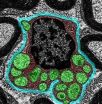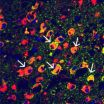(Press-News.org) Researchers from the Icahn School of Medicine at Mount Sinai have discovered that a particular protein prevents normal cells from being reprogrammed into cells that resemble stem cells, providing new insight into how they may lose their plasticity during normal development. This finding has broad-reaching implications for how cells change during both normal and disease development. The data are published this week in Nature Communications.
In a previous study, Emily Bernstein, PhD, and her team at Mount Sinai studied the natural progression of melanoma using mouse and human cells, as well as patient samples, and found that the loss of a specific histone variant called macroH2A, which is a protein that helps package DNA, was directly related to the growth and metastasis of melanoma. In the current study, her team wanted to find out how this molecule might act as a barrier to cellular reprogramming. The importance of cellular reprogramming has been recently highlighted by the winners of the Nobel Prize of Medicine (2012), and explores the capacity of reversing adult cells to an early stage of development, the so called embryonic stem cell.
Working with researchers at the University of Pennsylvania, Dr. Bernstein evaluated mice that were genetically engineered to lack macroH2A in comparison to control or "wild-type" mice. They used skin cells from these mice and attempted to reprogram the cells in petri dishes into pluripotent cells. They found that the cells derived from mice without macroH2A were much more plastic, meaning they were more easily reprogrammed into stem-like cells, compared to the wild-type mice. This indicates that macroH2A may block cellular reprogramming by silencing genes required for plasticity.
"This is the first evidence of the involvement of a histone variant protein as an epigenetic barrier to induced pluripotency (iPS) reprogramming," said Dr. Bernstein, who is an Assistant Professor of Oncological Sciences and Dermatology at the Graduate School of Biomedical Sciences at Mount Sinai, and corresponding author of the study. "These findings help us to understand the progression of different cancers and how macroH2A might be acting as a barrier to tumor development."
Next, Dr. Bernstein and her team plan to create cancer cells in a petri dish by manipulating healthy cells with genetic mutations often associated with cancer, coupled to removal of macroH2A to examine whether the cells are capable of forming tumors.
###
This study was supported by funding from a New York State Stem Cell Science Award (C024285) and a National Institutes of Health Grant (R01CA154683).
About The Mount Sinai Medical Center
The Mount Sinai Medical Center encompasses both The Mount Sinai Hospital and Icahn School of Medicine at Mount Sinai. Established in 1968, the Icahn School of Medicine is one of the leading medical schools in the United States, and is noted for innovation in education, biomedical research, clinical care delivery, and local and global community service. It has more than 3,400 faculty in 32 departments and 14 research institutes, and ranks among the top 20 medical schools both in National Institutes of Health (NIH) funding and by U.S. News & World Report.
The Mount Sinai Hospital, founded in 1852, is a 1,171-bed tertiary- and quaternary-care teaching facility and one of the nation's oldest, largest and most-respected voluntary hospitals. In 2012, U.S. News & World Report ranked The Mount Sinai Hospital 14th on its elite Honor Roll of the nation's top hospitals based on reputation, safety, and other patient-care factors. Mount Sinai is one of 12 integrated academic medical centers whose medical school ranks among the top 20 in NIH funding and by U.S. News & World Report and whose hospital is on the U.S. News & World Report Honor Roll. Nearly 60,000 people were treated at Mount Sinai as inpatients last year, and approximately 560,000 outpatient visits took place.
For more information, visit http://www.mountsinai.org/.
Find Mount Sinai on:
Facebook: http://www.facebook.com/mountsinainyc
Twitter @mountsinainyc
YouTube: http://www.youtube.com/mountsinainy
Protein lost in tumors blocks normal cells from being reprogrammed into stem cells
2013-03-07
ELSE PRESS RELEASES FROM THIS DATE:
Researchers explain a key developmental mechanism for the first time in plants
2013-03-07
Cold Spring Harbor, NY -- The normal development of an animal or plant can be compared in at least two ways with the successful performance of a great symphony. The whole is the product of a great number of events involving contributions by many different "players"; and these contributions must occur in a precise and almost perfectly coordinated temporal and spatial sequence.
In simple animals like the fruit fly and more recently in plants and mammals, scientists have been able to identify some of the principal players in the developmental symphony. Today, a team ...
UTHealth researchers report prevalence of sexting among minority youth
2013-03-07
HOUSTON—(March 6, 2013)—Researchers at The University of Texas Health Science Center at Houston (UTHealth) have found that up to 30 percent of minority youths reported sending or receiving "sexts," which are sexually explicit messages sent through technology including photos, videos and text-only messages.
"Although sexting is relatively common among youth and there has been a lot of attention about sexting in the media, there hasn't been much about sexting among ethnic minority youth," said lead investigator Melissa Fleschler Peskin, Ph.D., assistant professor of behavioral ...
A sausage a day is too many
2013-03-07
This press release is available in German.
"We estimate that three percent of all premature deaths can be attributed to the high consumption of processed meat," summarizes Sabine Rohrmann from the Institute of Social and Preventive Medicine at the University of Zurich. Teaming up with research colleagues from ten countries, she has been studying the link between the consumption of processed meat and the risk of mortality as part of a Europe-wide study with around 450,000 participants.
People who eat a lot of processed meat such as sausage products, salami or ham ...
New clues to causes of peripheral nerve damage
2013-03-07
Anyone whose hand or foot has "fallen asleep" has an idea of the numbness and tingling often experienced by people with peripheral nerve damage. The condition also can cause a range of other symptoms, including unrelenting pain, stinging, burning, itching and sensitivity to touch.
Although peripheral neuropathies afflict some 20 million Americans, their underlying causes are not completely understood. Much research has focused on the breakdown of cellular energy factories in nerve cells as a contributing factor.
Now, new research at Washington University School of Medicine ...
Improving electronics by solving nearly century-old problem
2013-03-07
RIVERSIDE, Calif. (http://www.ucr.edu) — A University of California, Riverside Bourns College of Engineering professor and a team of researchers published a paper today that shows how they solved an almost century-old problem that could further help downscale the size of electronic devices.
The work, led by Alexander A. Balandin, a professor of electrical engineering at UC Riverside, focused on the low-frequency electronic 1/f noise, also known as pink noise and flicker noise. It is a signal or process with a power spectral density inversely proportional to the frequency. ...
Some brain cells are better virus fighters
2013-03-07
Viruses often spread through the brain in patchwork patterns, infecting some cells but missing others. New research at Washington University School of Medicine in St. Louis helps explain why. The scientists showed that natural immune defenses that resist viral infection are turned on in some brain cells but switched off in others.
"The cells that a pathogen infects can be a major determinant of the seriousness of brain infections," says senior author Michael Diamond, MD, PhD, professor of medicine. "To understand the basis of disease, it is important to understand which ...
Breaking the rules for how tsunamis work
2013-03-07
The earthquake zones off of certain coasts—like those of Japan and Java—make them especially vulnerable to tsunamis, according to a new study. They can produce a focusing point that creates massive and devastating tsunamis that break the rules for how scientists used to think tsunamis work.
Until now, it was largely believed that the maximum tsunami height onshore could not exceed the depth of the seafloor. But new research shows that when focusing occurs, that scaling relationship breaks down and flooding can be up to 50 percent deeper with waves that do not lose height ...
Scientists improve transgenic 'Enviropigs'
2013-03-07
A research team at the University of Guelph has developed a new line of transgenic "Enviropigs." The new line of pigs is called the Cassie line, and it is known for passing genes on more reliably. The results of this project were published ahead of print in the Journal of Animal Science.
Enviropigs have genetically modified salivary glands, which help them digest phosphorus in feedstuffs and reduce phosphorus pollution in the environment. After developing the initial line of Enviropigs, researchers found that the line had certain genes that could be unstable during reproduction ...
Study finds risk of brain damage in college football players, even among those without concussions
2013-03-07
Wednesday, March 6, 2013, Cleveland: Concussions are the leading cause of brain damage in sports, particularly in football. However, researchers at Cleveland Clinic and the University of Rochester have found that football players may suffer long-term brain changes even in the absence of concussion.
In a study of 67 college football players, researchers found that the more hits to the head a player absorbed, the higher the levels of a particular brain protein that's known to leak into the bloodstream after a head injury. Even though none of the football players in the ...
Scientists at A*STAR's Genome Institute of Singapore catch evolving germs and cancer cells early
2013-03-07
Scientists at A*STAR's Genome Institute of Singapore (GIS) have developed a novel technique to precisely monitor and study the evolution of micro-organisms such as viruses and bacteria. This is an extremely important capability as it allows scientists to investigate if new drugs designed to kill them are working, and catch the development of resistance early on.
Micro-organisms and cancer cells evolve more quickly than normal human cells as their rapid life-cycles enable faster selection of advantageous mutations. Previously, scientists have had to wait for the selection ...

